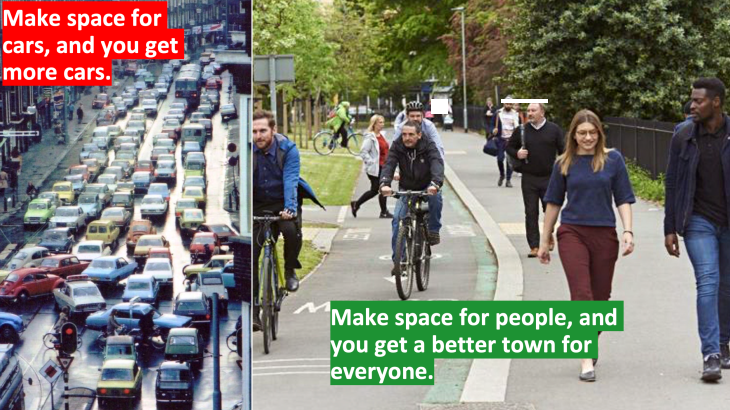WNC Local Transport Plan

The Local Transport Plan (LTP) is a document that sets out a long-term strategy for transport in West Northamptonshire and is currently open for public consultation. This consultation is due to end on the 17th October so it is really important to start getting feedback in.

The LTP is referring to transport in its broadest sense, so anything that moves people or goods is considered within the plan. As you might expect, it is of significant interest to those of us who are concerned about our environment as the way we travel is inextricably tied to our impact on the environment.
The problem is that plan documents are often long, laborious and inaccessible. I am afraid that the Local Transport Plan up for consultation this year can be similarly described. I am no expert when it comes to strategy documents though I try my best to read them and I often console myself that a fresh pair of eyes is better than those that have read it all before. With this in mind, I will try my best to draw out the structure of the document as well as the items worthy of note in the hope that some may find it useful. If nothing else, perhaps it will assist me in making up my own mind!
The plan can be split roughly into four parts:
1) The Context
2) The Vision/Aims/Intentions
3) The Interventions
4) The indicators of success
The Context
This is something we are familiar with but let me quote some lines from the Plan to demonstrate that, at the very least, its author is no stranger to reality:
“The Total resident population in West Northants has increased by 13.5% over 10 years…This is one of the largest increases in the East Midlands and is higher than the average 6.6% increase for England”
“In West Northants 23% of households indicated that one person in their household is disabled”
“West Northants, in 2021, had the second highest levels of greenhouse gases emitted from transport of any local authority area in the UK”
“Transport emissions now account for 47% of all emissions generated in West Northants, up from 36% in 2005”
“72% of households [In West Northants] own one or two cars. For the East Midlands this figure is 70% and for England 67%.”
“Between 2011 and 2021 bus travel to work increased slightly from 4% to 5%...the share of people cycling remained at 2%”
I have been selective here but I believe the document contains these facts for a very good purpose and, importantly, it has not shied away from them.
The Vision
Set 20 years hence in 2045 the document sees a West Northants which has changed significantly:
“moved rapidly to achieve net zero emissions”
“walking and cycling are the natural first choices for short trips”
“travel by public transport has become increasingly attractive and accessible”
“communities are less dependent on private cars”
“Our transport system is safer and cleaner”
The Interventions
Next come 6 objectives with 16 policies that inform them and, usually the most interesting part of the document, associated interventions (short, medium and long term):
Objective 1 “Improve the accessibility of the public transport, walking and cycling networks, to promote a system that is fair and provides attractive travel alternatives to key destinations”
Objective 2 “Create thriving communities through local investment in a more resilient transport network, services and the public realm in urban and rural towns and villages across West Northants”
Intervention examples:- available on page 33
- A43 dualling Northampton to Holcot/Sywell
- Bus Priority Corridor Programme
- New railway station serving Weedon Bec/Daventry
Followed then by policy commitments that the council make over the next 5 year period, these are available on Page 36 for Policy 1.
I won’t bore you by going through every individual policy and commitment but I will copy the objectives here and if one is of interest then you can find the rest of the information in the pages that follow it:
Objective 3 (Page 44) - Improving Road Safety and reducing pollution, while expanding active travel networks and supporting infrastructure that facilitates public health outcomes
Objective 4 (Page 44) - Enhance local environments and further reduce carbon emissions from transport by investing in low carbon and electric modes, without compromising local heritage
Objective 5 (Page 58)– Reducing inequalities through better transport connections to key employment and education opportunities, to support local socio-economic growth.
Objective 6 (Page 58) – Maximise the benefits to communities and businesses through use of technology and innovation
Next in the document (Page 58 onward) are set out routes for potential funding and the importance of having a consistent Local Transport Plan when applying for this funding. Well worth a read if you want to gain a better understanding as to the various pots of money that exist when it comes to local transport.
Success Indicators
Starting from Page 81 we get the success indicators i.e. what stats are they going to use to inform whether they’ve succeeded or not. For example, on the objective of improving road safety, a decrease in total accidents will help to show if the council are doing something right.
These will prove very useful if we want to hold our council to account in the future. Firstly by whether they obtain and publish these metrics. Secondly, and crucially, whether they have stuck to them.
So what?
What it all boils down to is a few simple questions:
- Do you think the context is demonstrative of reality?
- Do you think the vision/aims are reasonable in the light of the context?
- Do you think the objectives are consistent with the aims?
- Do you think the policy commitments assist the objectives?
- Do you think the interventions are realistic and assist toward the objectives/aims?
- Do you think the markers of success are fair?
My view is that the context couldn’t be clearer and the Plan does not shy away from the challenges we face in West Northamptonshire when it comes to population growth, pollution and deprivation. I think the vision is a good one but I am reminded of so many times in the past where this council has promised the world and delivered very little. What is it about this plan that commits us to this vision?
I think the objectives are fair though the language could be more committed toward the vision, could we include success indicators within the objectives, for example? The policy commitments deviate even further from tangible action and, whilst this is a high level document, I just know that without clear courses of action, we are prone in West Northamptonshire to being stalled by the lack of commitment in these kinds of document.
On the interventions, I have to resist the urge to be flippant and offer a wager that the ones involving road development will be completed in the next 10 years whilst the Active Travel network, the rail improvements and the bus service ideas will all fall down in the priority list. The council needs to get serious about these interventions. How do we communicate these priorities in a more solid way?
The markers of success do seem fair – let’s hold this council to them by including some of them front and centre within the objectives and maybe even within the vision itself. Reduction of road accidents is surely something we could all rally behind as an example.
This about sums up my entire view of the Local Transport Plan; it is full of glorious words but is it just another tick box exercise? In truth, I believe it is down to organisations like CA-WN, and its members, to answer that question.
Ultimately, consultations are down to you and so please read the document if you have the time and form your own opinion.
There is an option to respond to the consultation by email to tell the council what you think its transport priorities should be, as an alternative to reading and critiquing the LTP.

